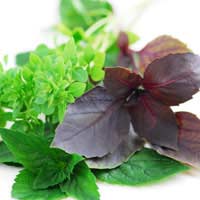Using Basil in Italian Cooking

If any aromatic could lay claim to the title of signature herb when it comes to Italian food, then surely basil must be the odds-on favourite. There is something about its warm, sweet nature that even in the grip of a fierce northern European winter can transport you back to those long, lazy summer days in the Mediterranean. These quasi magical properties also extend to palate, where the addition of basil can leave the diner spellbound.
How Basil Features In Italian CookingBasil prominently features in two of the Bel Paese’s most famous inventions, insalata tricolore and pesto. In both recipes, the leaf is used in its raw state, providing the more dominant flavour in the finished article. The tricolore refers to the three colours of the Italian flag that make up the salad: the red of the tomatoes, the white of the creamy mozzarella, and the vibrant green, represented by the basil. The success or failure of the dish rests solely on the quality of the individual products, so it is worth taking a little time to shop with quality at the top of your list of priorities. The same philosophy should apply to the olive oil used to dress the finished salad.
Pesto: The Essence Of The Ligurian Region
Pesto, the essence of the Ligurian region from which it originates, can be found in a wide variety of commercially produced packaging on supermarket shelves the world over, but given the simplicity of the method, it is rewarding to take the trouble of making your own. The recipe for pesto, along with the one for the insalata tricolore, can be found in the famous recipes section of this site.Basil in a Pizza or Puttanescan Sauce
Another famous offering that features basil is the pride of the Neapolitan kitchen, the pizza margherita. Naples is also the home of puttanesca sauce, a fierce tomato-based accompaniment to spaghetti or penne that is proof that basil can fight its corner, even when confronted by a fellow ingredient as formidable as chilli.Along with the ubiquitous plum tomatoes, garlic, olives and capers are the other components in a culinary invention that reflects the fiery reputation of the southern seaport from which it originates. Indeed, introduce a little too much heat and you may be forgiven for thinking your tongue is experiencing the molten outpourings of nearby Vesuvius itself.
Fish with Fresh Basil Leaves and Lemon Juice
A more gentle experience can be gained from baking a piece of fish al cartoccio with some fresh basil leaves, a good squeeze of lemon juice, along with some grated zest, seasoning and a generous drizzle of olive oil. A white fish such as cod or haddock works well because the mild flavour of the meat allows the basil to showcase its attractions.In common with other herbs, dried basil is widely available. It can work well in tomato-based pasta sauces but otherwise is no match for fresh. If you are intending to grow the herb in your garden or allotment, or even propagate it on your window sill, be sure to buy the Sweet Basil seeds rather than the Holy or Purple varieties as it is the former that is utilised in the Italian kitchen.


Re: The Structure of an Italian meal
When my grandpa returned from serving in the Navy during the Korean War, he disembarked in New York City, but lived in…
Re: Tomatoes and the Italian Culture
Susie - Your Question:Great advice on peeling and deseeding tomatoes. I was always anti because I believed the flavour was in…
Re: Tomatoes and the Italian Culture
Great advice on peeling and deseeding tomatoes. I was always anti because I believed the flavour was in the seeds and juice.…
Re: How to Make Traditional Sweet Ravioli
my question is. can I roll the dough out using my pasta machine or will the dough just get stuck
Re: Aperitivi, Digestivi and Other Mealtime Drinks
lips - Your Question:I would like to know what a formal diner in 1939 in Italy(Sicily) amongst the wealthy…
Re: Aperitivi, Digestivi and Other Mealtime Drinks
I would like to know what a formal dinner in 1939 in Italy(Sicily) amongst the wealthy was like- What was…
Re: Olive Oil Production
@Polly. This seems strange to find in the UK as regulations are quite stringent in terms of product descriptions. Here the informat
Re: Olive Oil Production
Have used what I believed to be virgin olive for years, well known brand, only to find that 70% of brands contain little olive oil and are…
Re: The Perfect Slow Cooker Ragu
@SaraBrown - a 1kg carton would be the best for this recipe. Add a bit at time though to ensure it's a consistency that you like.
Re: The Perfect Slow Cooker Ragu
Hi what size carton of passata please? I can buy anything from 200g to 1kg Thank you